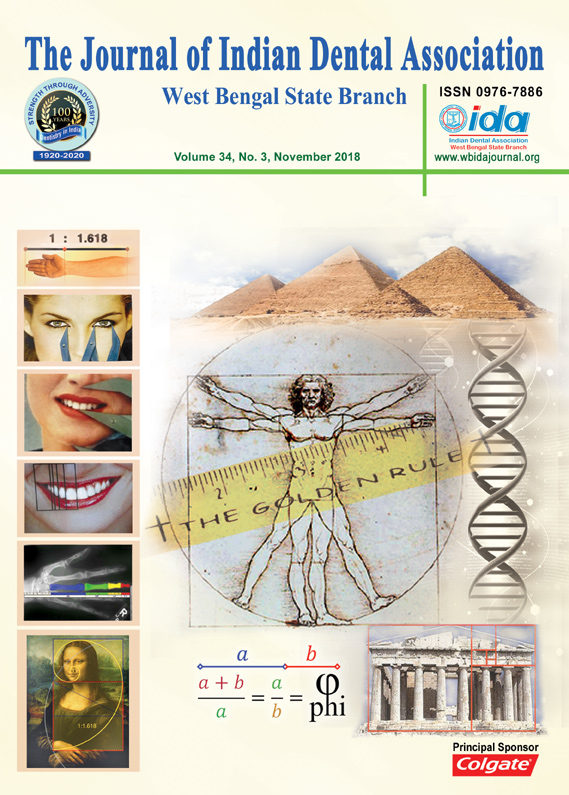Upcoming Events
1. Article Title.
2. Author Details.
3. Abstract.
4. Keywords.
5. Corresponding Author details.
November 2018
Volume : 34
No.: 3

Dr. Raju Biswas,Dr. Subir Sarkar,Dr. Subrata Saha
Abstract: Now-a-days management of dental caries has shifted to more preventive and minimally invasive approaches. Carious lesion in its early stage can be remineralized which not only halt the disease progression, but also restore normal morphology, esthetic and function. Remineralization of early carious lesion can be done with a variety of remineralizing agents which include both fluoride and non-fluoridated agents. The aim of this paper is to review the contemporary remineralizing agents available for the treatment of early carious lesion and to explore the ideas for their relevant use in clinical practice.
Dr. Seema Rathi,Dr. Abhisek Chowdhury,Dr. Samridhi Thapa,Dr. T.K. Giri,Dr. Sugata Mukherjee
Abstract: Management of benign or malignant tumor associated with mandible represent a difficult challenge for surgeon and prosthodontist in term of both removal of primary disease followed by rehabilitation. Depending upon location, extent and nature of the tumor, various treatment modalities like marginal, segmental, hemi or total mandibulectomy is indicated . Surgical resection of mandible is the commonest cause of mandibular deviation resulting in altered mandibular movement that leads to difficulties in swallowing and speech, compromised control of salivary secretion as well as severe cosmetic disfigurement. A corrective device known as guiding plane prosthesis is used to limit these manifestations. It is a device which aids for both physiotherapy and mastication. These case reports describe early prosthodontic intervention of a hemimandibulectomy patient with guiding plane prosthesis for correction of deviated mandible improving function and esthetics in post operative period.
Dr. Samridhi Thapa,Dr. Seema Rathi,Dr. T.K. Giri,Dr. Sugata Mukherjee
Abstract: Rehabilitation of edentulous patients in prosthodontics has long been a major concern and a challenge for dentistry. In the past and even today, complete maxillary and mandibular denture are the traditional standard of care. However, most of the patients have issues adapting to their dentures mainly because of increased residual ridge resorption which leads to decreased retention, stability and inability to chew and eat efficiently. Overdenture aid in decreasing residual ridge resorption by preserving the already present abutments in the dental arch. This article presents a case report on the prosthetic rehabilitation of a partially edentulous upper arch of a patient by two tooth supported conventional over denture.
Dr. Shreya Das,Dr. (Prof.) Anjana Mazumdar,Dr. Sandip Ghose
Abstract: Dyskeratosis congenita is a rare hereditary disorder, estimated to occur in 1 in 1 million people. Most cases are inherited as X linked recessive trait resulting in a striking male predilection. The disease is characterized by a classic triad: nail dystrophy, skin pigmentation and oral leukoplakia. These patients may also exhibit involvement of various organs like lung, G.I. tract, genitourinary tract, brain and teeth. Early mortality is often due to bone marrow failure, infection, fatal pulmonary complication or malignancy. Here, a case of dyskeratosis congenita in a 14 year old boy is presented who had all the characteristics of classic triad and few additional features.
Dr. Shreya Das,Dr. (Prof.) Anjana Mazumdar,Dr. Sandip Ghose
Abstract: Ameloblastomas are benign epithelial odontogenic neoplasms which are locally aggressive. Based on the clinical, radiographical, histopathological, behavioral and prognosis, four variants of ameloblastoma are present. They include solid/multicystic ameloblastoma, unicystic ameloblastoma (UA), peripheral ameloblastoma (PA) and desmoplastic ameloblastoma. Peripheral ameloblastoma is a rare, benign, extraosseous odontogenic soft tissue tumor that accounts for 2-10% of all ameloblastomas. It usually occurs in the gingiva or alveolar mucosa. The PA represents the same histological characteristics of intraosseous ameloblastoma, although it is less aggressive than this classical subtype. Here, a case of peripheral ameloblastoma in a 48-year-old-male affecting the lingual alveolar mucosa of the mandibular premolars is presented which was clinically diagnosed as pyogenic granuloma and also described about the importance of histological examination to the diagnosis.
Dr. Swapan Kumar Majumdar,Dr. Divya Chadda,Dr. Jayanta Saha,Dr. Aritra Chatterjee,Dr. Sanjoy Roy,Dr. Mustafizur Rahaman
Abstract: The impacted mandibular second molar is a rare finding. The arrest in the eruption of the lower second molars can lead to disturbances of aesthetics and mastication. Various treatment options could be proposed for malposition and impaction of second molar. The treatment approach of choice may be decided on the basis of evaluation of factors like amount of space present in the dental arch (if any), status of adjoining teeth and patients' choice. Accurate location of the impacted molar by the means of cone beam computed tomogram aids in the appropriate treatment plan. In this article, we report a case of impacted lower second molar which was managed by surgical treatment.
Dr. Sanjoy Dutta,Dr. Rinchey Norbu Bhutia,Dr. Diptangshu Garai
Abstract: Myiasis is a medico-pathological term used to describe the infestation of dead or living tissue of vertebrates by larvae/maggots of certain dipteran flies. Human oral myiasis is rare and unique as the oral cavity is protected from the external environment. Here, we discuss a case of oral myiasis in the maxillary anterior region reported in our department.
Dr. (Prof.) S.K. Majumdar,Dr. Aritra Chatterjee,Dr. Soumen Mandal,Dr. Mohsina Hussain,Dr. Malay Kanti Bachhar,Dr. Anirban Raha
Abstract: Several methods exist for treating fractures involving the zygomatic complex. They include open reduction, intra-oral elevation (Keen’s Approach), antral packing, and extra-oral elevation (Gillies method). However, when reviewing the literature, it would appear that marked differences exist in the method most frequently used, and this would appear to be dependent on the country in which the patient is treated. For example, in the United States open reduction is favoured, whereas European countries appear to favour closed reduction. The Gillies approach, is frequently used because of the short duration of general anaesthesia and minimal morbidity, does not appear to be used frequently in the United States, perhaps due to a lack of familiarity with the procedure and its versatility. However, in India, specially in tertiary care centres like ours with a heavy patient load, the Gilles Temporal Approach, a relatively simple and less time consuming procedure is frequently performed.
Dr. Paromita Mazumdar,Dr. Indrajit Biswas,Dr. Chiranjan Guha
Abstract: AIM-Microleakage and internal voids were evaluated in classII composite resin restoration using flowable and packable composite resin with various curing protocols. METHODOLOGY-Thirty non carious molar teeth were taken, class II cavities were prepared, acid etching was done and randomly divided into three groups: Group I-Bonding agent was placed, cured and samples were restored with packable composite resin and then cured again; Group II- Bonding agent was placed and cured, samples were lined with flowable composite and cured. Subsequently cavities were restored with packable composite resin and cured again. Group III- Bonding agent was placed and samples were lined with flowable composite resin and cured together and restored with packable composite resin and cured. Longitudinal sections were made in mesio-distal direction and were examined under a stereomicroscope. Internal voids was recorded in the cervical and occlusal surfaces of restorations. Gingival-marginal microleakage was also be recorded. RESULTS- The mean microleakage and void score of group I is higher compared to other groups and the mean microleakage and void score of group II is lowest compared to other groups. CONCLUSION- According to this in vitro study it can be concluded that within the limitations of this study, it is preferable to cure the flowable composite liner separately followed by curing of packable composite to reduce microleakage and internal voids.












